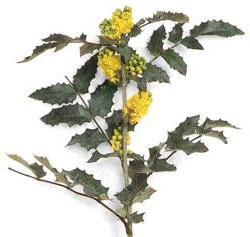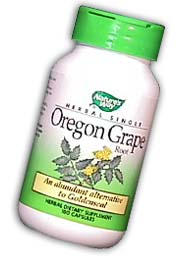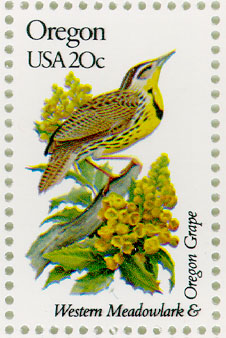|
Mahonia aquifolium has a huge variety of medicinal and therapeutic uses.
ECOLOGY
A low growing plant, the Oregon Grape is native to much of the Pacific Coast and found sparsely east of the Cascades. Its year-round foliage of pinnated, waxy green leaves resembles holly. The plant bears dainty yellow flowers in early summer and a dark blue berry that ripens late in the fall. The roots are used in herbology as a nutritional aid to the digestive and circulatory systems. It has been known to grow near hedges, in woodlands, at sunny edges, in dappled shade, and in areas with heavy ground cover. Natural stands contain scattered individual plants arising from seeds and also contain clumps of Oregon Grape.
|
HISTORY
Native Americans have used it for thousands of years for medicine, food, and dye. It was adopted as the state flower or Oregon in 1899. Oregon Grape has been used to treat all of the following ailments: poor liver function, digestive problems, eczema, acne, giardia, herpes, and malaria (Wiesenauer and Ludtke 1996).It is most commonly used for its function as an anti-inflammatory, and antibiotic properties. The primary active chemical constituent is an alkaloid called berberine, also found in goldenseal and barberry. The plant uses this alkaloid for one of the same reasons humans do, to defend roots against microbial invasion. |
|
|
There are a few main varieties of the Oregon Grape, Mahonia aquifolium, Mahonia repens, and Mahonia nervosa. Mahonia generally ranges from the west coast to the eatern slopes of the Rockies, north the British Colombia, and south the central California, Colorado, Mexico and northern Arizona. Mahonia aquifolium is most common in the northwest and can be seen while hiking around Eugene. It is a shrub but can grow up to seven feet tall. It is distinguishable because its leaves are waxy and point and resemble holly leaves. To find it, look near large stands at the edge of dense cover. It reproduces clonally and rhizomatically (Duke 1995). |
ECONOMICS
Oregon Grape root is a rather widely distributed herbal medicine on the national and international market (Brown 1995). It sells for anywhere from three dollars a pound for non-wildcrafted roots and powders to $43.99 for a four ounce wildcrafted organic tincture. Little study has been done on the means by which this product reaches the market. A very important issue that will affect this medicines market value is ethical harvesting. People will pay more to know that the product harvested in good locations and in an ethical way. For example if it was picked out of season or near a road that had possibly been sprayed than consumers will pay less than if it was picked in season by a permitted harvester out in the middle of the forest where no spraying would have occurred.
|
POLICY AND MANAGEMENT
There are no regulations specific to harvest of Oregon Grape on public or private lands. It is protected by policies that govern many other common medicinal plants in our publicly owned forests. The McKenzie Ranger district states that its only regulation is on personal use and that commercial use is not significant enough to warrant its management. In most cases NTFPs harvested for commercial use are required to have permits on Forest Service Land. When the demand for this herb rises so will regulations and management.
*Compiled from a paper by: Nickolas Gillespie |
|
|



